Worcestershire Record No. 27 November 2009 pp. 7-12
AN ACCOUNT OF UNCOMMON INSECTS I HAVE RECORDED AT THE MILL MEADOW/MILL
ROUGH COMPLEX SINCE 1996
Kevin McGee
Mill Meadow, Drakes Broughton, at Grid Ref SO919483, is a small nature
reserve managed but not owned by Worcestershire Wildlife Trust. The meadow is
a little less than the size of a football pitch and is surrounded on three
sides by a large block of mixed Oak, Ash and Aspen woodland known as Mill
Rough; this is not owned by the Trust nor is it managed or protected
for wildlife. The meadow is cut annually to maintain the rich and diverse
flora, it has not been ploughed for at least 75 years and is a tiny remnant of
original Worcestershire ‘pasture woodland’.
I have been collecting species records from this site since about 1996. As
my own personal interest in the various entomological groups has developed,
and my knowledge has increased, it has become apparent that Mill Meadow and
the surrounding Mill Rough is home for many localised and rare insect species.
Many only exist because of the continued presence and maintenance regime of
the meadow itself, but so too do many occur due to the proximity of the
woodland. This is why I have included rare species recorded from both the
meadow and the surrounding woods in this article as there is a clear
relationship between the two habitats.
A full list of all the species I have recorded is with Mr.G.H.Green. Most
are common and widespread, a fair number are less common but would still be
expected at such a rich site so I have only included those species I feel
should be given a special mention in this article, otherwise it would be too
long!
In most instances I have given the national conservation status accorded to
each species, please note that in the case of the Aculeates I have supplied
the national status as advised by M.E.Archer. Any other notes or comments on
abundance are entirely my own observations.
LEPIDOPTERA; BUTTERFLIES
A total of 28 species recorded.
LYCAENIDAE.
Common Blue. Polyommatus icarus. A small but stable population
at Mill Meadow and around field boundaries of Mill Rough of this locally
declining species.
Brown Argus. Aricia agestis. An increasing population, following
the local trend.
White-letter Hairstreak. Satyrium w-album. Very elusive, but
does occur in hedgerow Elms.
NYMPHALIDAE
Silver-washed Fritillary. Argynnis paphia. Very rare, but I do
have two records from the brookside at the Mill Rough/Deerfold Wood boundary.
White Admiral. Limenitis Camilla. A very small population seems
to be fairly stable, never more than one or two seen on the same day.
Occasionally seen within Mill Meadow itself.
LEPIDOPTERA; MACRO MOTHS
A total of 93 species recorded. All are from casual daytime encounters of
moths found or disturbed from foliage, and from larval records. Therefore I
have only scratched the surface; running a light-trap at regular intervals
would obviously be the only way to gain an accurate picture. This comment also
applies to my Pyralidae & Micro Moth records.
ARCTIIDAE
Rosy Footman. Miltochrista miniata. Local. A few records of
adults disturbed during the day.
GEOMETRIDAE
The Mocha. Cyclophora annularia. Notable B. One disturbed from
foliage at Mill Rough on 14.5.2006.
Drab Looper. Minoa murinata. Notable B. A very small population.
One or two seen annually alongside Mill Rough.
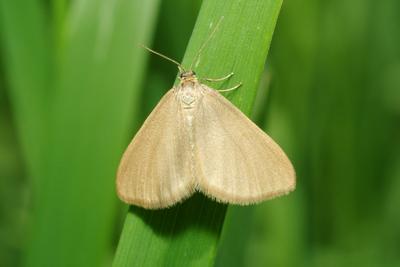 |
Drab Looper © K.McGee
|
NOCTUIDAE
Alder Moth. Acronicta alni. Local. One record of an adult on an
Oak trunk, Mill Meadow, 3.5.1999.
Waved Black. Parascotia fuliginaria. Notable B. One record of 3
larvae on an Oak log at Mill Meadow on 23.4.2000. Confirmed from photo by ANB
Simpson.
SESIIDAE.
Hornet Moth. Sesia apiformis. Notable B. A pair in-cop on low
vegetation at Mill Meadow on 1.7.2001.
Yellow-legged Clearwing. Synanthedon vespiformis. Notable B. A
female was photographed ovipositing in the outer bark of an Oak stump near Mill
Rough on 21.6.2003. This was the remaining stump of a large Oak that had been
blown over during gales in the previous winter.
LEPIDOPTERA; PYRALIDAE
A total of 20 species recorded.
Antigastra catalaunalis. Rare Migrant. One disturbed from a field
boundary at Mill Rough on 23.9.2006.
Sitochroa palealis. Notable B. One record of a worn adult photographed at
Mill Meadow on 21.8.2005. This specimen may have wandered in from elsewhere as
it is known to have migratory instincts.
LEPIDOPTERA; MICRO MOTHS
A total of 99 species recorded.
GELECHIIDAE
Parachronistis albiceps. Local. One collected from an Oak trunk at Mill
Meadow on 2.7.2001 was identified by ANB Simpson.
INCURVARIIDAE
Adela fibulella. Local. Very elusive on flowers of Speedwell, but I do
have records from Mill Meadow and around the boundaries of Mill Rough.
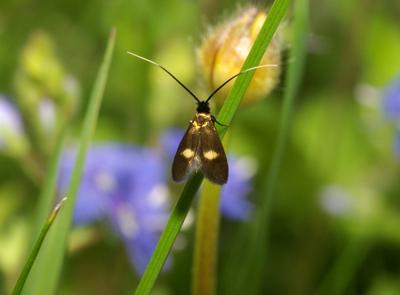 |
Adela
fibulella
© K.McGee |
Nemophora minimella. Local. Very rarely seen, this is a late summer
species unlike others within the family. Can be found on Angelica flowers in
Mill Meadow.
TORTRICIDAE
Ancyllis laetana. Local. One record of an adult photographed on an Aspen
trunk at Mill Meadow on 12.5.2007. Aspen is the larval foodplant.
Pammene germmana. Notable B. One photographed on Oak foliage at Mill
Meadow on 28.5.2000. Identified by ANB Simpson. Known to be associated with
mature Oak woodland.
Pammene trauniana. pRDB3. One photographed on Field Maple foliage
alongside Mill Rough on 20.5.2007. Identified by ANB Simpson. The larva feeds in
the developing seeds of Field Maple.
Spatalistis bifasciana. Notable B. One photographed on an Aspen trunk at
Mill Meadow on 29.5.2007. Confirmed by ANB Simpson.
HEMIPTERA; HETEROPTERA
A total of 75 species recorded.
LYGAEIDAE
Megalonotus antennatus. Notable B. One collected from grass/leaf-litter
at Mill Meadow on 2.1.2005. Confirmed by PF Whitehead.
Peritrechus nubilus. Local. Three records of specimens collected from
grass/leaf litter at Mill Meadow during winter months.
MIRIDAE
Heterocoridylus genistae. Local. This species is confined to one
foodplant; Dyer’s Greenweed. A healthy population of this locally scarce plant
occurs at Mill Meadow.
Megacoelum infusum. Local. I only have two records of this species, both
from Oak trunks at Mill Meadow, late summer 2002.
RHOPALIDAE
Stictopleurus abutilon. Rare Vagrant. A small population was discovered
amongst arable weeds on set-aside at Mill Rough during the early autumn of 2006.
Groundsel seemed to be the most popular foodplant. I’ve seen none since.
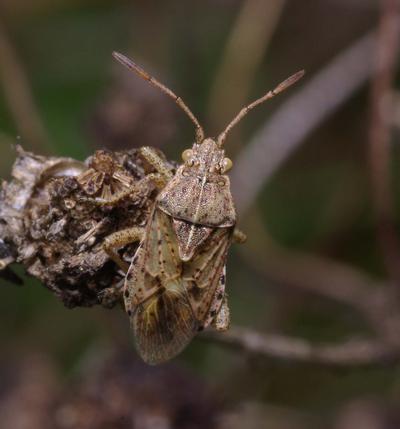 |
Stictopleurus
abutilon
© K.McGee. |
ODONATA
A total of 15 species recorded.
Beautiful Demoiselle. Agrion virgo. Local. A healthy breeding
population in the brook between Mill Rough and Deerfold Wood. Males occasionally
wander into Mill Meadow itself.
Club-tailed Dragonfly. Gomphus vulgatissimus. Notable B. Wandering
males are seen rarely in Mill Meadow.
COLEOPTERA
A total of 276 species recorded. I must emphasise that the vast
majority of these were identified or confirmed by Mr.P.F.Whitehead, particularly
so with small and obscure Staphylinids etc…
ANTHRIBIDAE
Platyrhinus resinosus. Notable B. Adults are found frequently on or
around log-piles, especially of Oak and Ash.
Platystomos albinus. Notable B. Very rare, only one record; adult on dead
Hazel logs at Mill Meadow on 24.4.2009.
ATTELABIDAE
Attelabus nitens. Local. Very rarely found on Oak foliage.
Rhynchites cavifrons. Notable B. Seems to be quite frequent here, several
records from the period covering late May to early June.
BUPRESTIDAE
Agrilus pannonicus. Notable A. First recorded on 30.5.2003 when several
were found ovipositing in bark of an Oak stump near Mill Rough. This stump was
created when a large Oak out in an open field was blown down during a storm at
some time in the previous winter. Since that initial discovery A.pannonicus
has established itself successfully in this area. Adults have also been seen on
the Oak stumps in Mill Meadow.
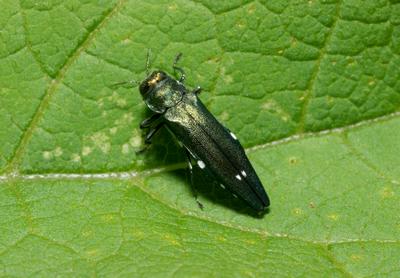 |
Agrilus
pannonicus
© K.McGee |
CARABIDAE
Acupalpus meridianus. Local. Just two records from Mill Rough, including
one from under a stone on 29.3.2003.
Agonum marginatum. Local. A single record of one collected from under an
Oak log at Mill Rough on 26.1.2008.
Anisodactylus binotatus. Local. Just a couple of records from Mill Rough
including one collected in-flight on 5.4.2003.
Carabus violaceus. Common. Although classified as nationally common this
is a distinctly scarce species in this area in my experience. Adults can
occasionally be found deep inside large logs during late winter in Mill Rough.
Nebria salina. Local. One collected from dry ground at Mill Meadow on
24.9.2005.
CERAMBYCIDAE
I have a particular interest in this family; the ‘Longhorn Beetles’. I’ve
recorded a total of 21 species at these two sites.
Grammoptera ustulata. RDB3. One photographed alongside Mill Rough on
5.5.2007. This is one of my most significant records. Mill Rough may well be the
only site in the midlands following my discovery of this rare longhorn beetle.
The photograph I took isn’t particularly good due to surrounding foliage
blocking out light from my flash gun, however, Paul Whitehead was able to
confirm from the image the identity of G.ustulata. It took flight after
just one photo and I have not seen one since.
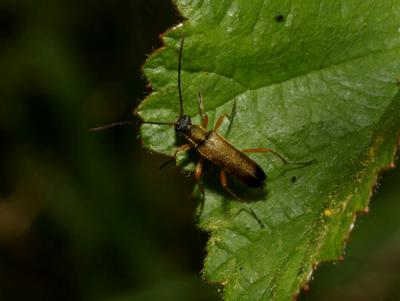 |
Grammoptera
ustulata
© K.McGee |
Judolia cerambyciformis. Local. This is well established and common in
the vicinity of Mill Rough and Deerfold Woods which is actually a bit of a
mystery as it certainly isn’t present at nearby Tiddesley. This longhorn
beetle would not go unnoticed.
Molorchus umbellatarum. Notable A. I have several records of this
nationally scarce species. Its associated with fruit trees and so has a direct
link with the history of fruit production in our part of the country; which as
we are aware is diminishing, with the resulting loss of old orchards. Look on
umbellifers in June.
Phymatodes alni. Notable B. I collected one of these from low vegetation
alongside Mill Rough on 29.5.2007. Then suddenly a concentration of them became
established on a pile of recently cut Oak logs/branches at Mill Meadow during
2008. On 1.6.2008 I estimated over 20 on this log-pile. This is a scarce beetle
with very few Worcestershire records.
Pyrrhidium sanguineum. RDB2. The sudden appearance of this spectacular
longhorn beetle in Worcestershire is now well documented (summaried by Umpelby
2009). I first found one on storm-blown Oak branches in an open field on
farmland not far from the Mill Rough complex in Drakes Broughton on 29.4.2007.
It subsequently appeared on Oak logs in Mill Meadow the following year; there
were 3 on 10.5.2008. I then saw one in flight land briefly on an Oak log
alongside Mill Rough on 23.5.2009 before taking flight again.
Stenostola dubia. Notable B. I have several records from Mill Meadow, all
of singletons during May.
ELATERIDAE
Ampedus elongantulus. Notable A. Three records from Oak stumps at Mill
Rough and Mill Meadow, all from late May, early June. Confirmed by P.F.Whitehead.
Ampedus rufipennis. RDB2. One collected from the stump of a fallen Oak,
Mill Rough, on 6.6.2004. Confirmed by P.F.Whitehead. This species is also
established in the large logs of storm damaged Ash trees on nearby farmland in
Drakes Broughton.
MELANDRYIDAE
Phloiotrya vaudoueri. Notable B. One photographed on an Oak log at Mill
Meadow on 19.8.2000. My only record of one anywhere.
OEDEMERIDAE
Ischnomera sanguinicollis. Notable B. Well established here and
relatively common, especially so on Field Maple blossom alongside Mill Rough.
PYROCHROIDAE
Pyrochroa coccinea. Notable B. Although fairly frequent in the north and
west of the county this species is rare in this area. I’m pretty certain it is
not present at Tiddesley, I have recorded it twice from Mill Rough.
SCARABAEIDAE
Gnorimus nobilis. RDB2. One of our local ‘celebrities’ for which this
part of the county is well known. I have four records of singletons from Mill
Meadow/Mill Rough going back to 2000. My most recent is of one photographed on
Hogweed flowers near Mill Rough on 23.6.2009.
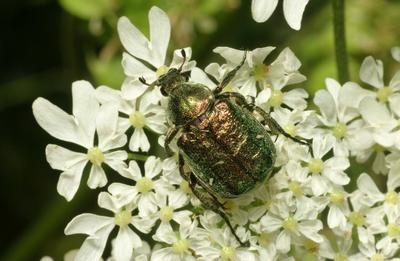 |
Gnorimus nobilis
© K.McGee |
STAPHYLINIDAE
Atheta boletophila. RDB2. One collected from under bark of a dead fallen
Oak near Mill Rough on 9.1.2005. This was identified by P.F.Whitehead who has
retained the specimen.
Platydracus latebricola. Notable B. Recorded from Mill Meadow, confirmed
by P.F.Whitehead.
Platydracus stercorarius. Local. Recorded from Mill Meadow, confirmed by
P.F.Whitehead.
TENEBRIONIDAE
Prionychus melanarius. RDB2. One collected from an Oak trunk in Mill
Meadow on 8.7.2006. Confirmed by P.F.Whitehead.
DIPTERA
A total of 142 species recorded. I’m only able to identify a limited number
of families so the true picture would only become clear from the work of a
dedicated dipterist. However, even my findings indicate that this is a rich
site.
ASILIDAE
Choerades marginatus. Notable. I have many records of singletons so it is
clearly well established. Easily seen sitting out in the open such as on top of
Oak stumps at Mill Meadow.
CONOPIDAE
Leopoldius signatus. Notable B. Very rare and elusive. I have just two
records of specimens netted from Ivy flowers, late September, early October.
Myopa extricata. RDB3. Seems to be frequent alongside Mill Rough.
Thecophora atra. Local. I have one record, a male from Devil’s-bit
Scabious flowers in Mill Meadow on 30.8.2003.
SYRPHIDAE
Brachyopa bicolor. RDB3. Two records; a female from Hogweed flowers at
Mill Rough on 6.6.2004 and a male from an Oak trunk in Mill Meadow on 5.5.2009.
Brachyopa pilosa. Scarce. Six males were congregated on a large branch of
Oak that had fallen on to the ground near Mill Rough on 2.5.2009. I collected
one of them. There were still a couple there on 23.5.09 but by now encroaching
nettles and brambles had almost engulfed the log.
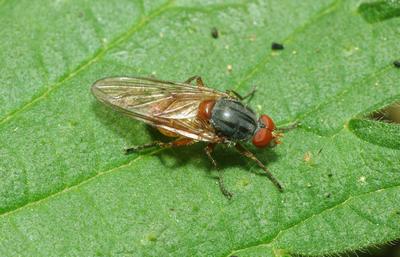 |
Brachyopa
pilosa, (male)
© K.McGee |
Brachypalpoides lentus. Local. Very scarce, I have a few records and
still not obtained the ‘perfect’ photo of one!
Brachypalpus laphriformis. Scarce. 2009 would seem to have been a good
year for this national rarity alongside Mill Rough. The fine spring weather
resulted in several records of individuals on large logs of dead Oak.
Cheilosia grossa. Local. Always very rare and difficult to find, seems to
have a very short flight period according to my records; the last week of March
to the first week of April.
Criorhina floccosa. Scarce. Very rare here, unlike the similar C.berberina
which I see regularly. Again, 2009 appears to have been a good year for it due
to fine weather in late April and early May when I saw and photographed several.
Didea fasciata. Notable B. A male collected from Bramble foliage at Mill
Meadow on 25.4.2009.
Volucella inanis. Notable B. Now frequent and common following the
nationwide expansion of its range, especially on Devil’s-bit Scabious flowers
in Mill Meadow.
Volucella inflata. Notable B. Rather scarce, 2009 was a good year due to
fine spring weather. This species is particularly fond of Dogwood flowers
according to my records.
Xanthogramma citrofasciatum. Local. I had always suspected the presence
of this species in Mill Meadow due to past possible sightings and situations
when I had failed to photograph/capture one. So I was pleased to confirm a
female X.citrofasciatum on 1.5.2009. Another female was photographed ovipositing
in leaf litter alongside an Ant-hill on 3.5.2009.
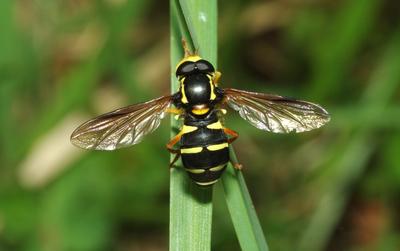 |
Xanthogramma
citrofasciatum, (male)
© K.McGee |
TABANIDAE
Hybomitra bimaculata. Local. Very scarce, the streamside area between
Mill Rough and Deerfold Wood is the only site I know of for this horse-fly. Four
records, all from hot days in June, early July.
Tabanus autumnalis. Local. Just one record; a female photographed at rest
on one of the Oak stumps in Mill Meadow on 28.6.2009.
TACHINIDAE
Tachina lurida. Local. A single record of one collected from low Brambles
at Mill Meadow on 1.5.2009.
THEREVIDAE
Pandivirilia melaleuca. RDB2. This is my most important record, not only
for the Mill Meadow/Mill Rough complex but anywhere! On 25.6.2009 during hot
humid weather at 3.00pm I netted an unfamiliar yet striking fly as it flew in a
manner not unlike a Pompilid Wasp amongst rank grasses near the base of an Oak
stump in Mill Meadow. I didn’t even attempt to photograph it as it was clearly
moving rapidly amongst the thick vegetation. I was amazed when I keyed it out
later as a female P.melaleuca. This is an extremely rare Stiletto-Fly
which according to Stubbs & Drake (2001) is only certain from Windsor Forest
and the immediate locality. There is also a possible larval record from
Cirencester Park, Gloucestershire (Alexander, 1994). Steven Falk has agreed with
my identification from a photograph of the dead specimen I e-mailed to him.
Unfortunately two of the legs were dislodged during the difficulty of capturing
this individual.
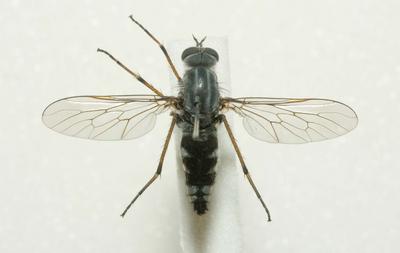 |
Pandivirilia melaleuca, (female)
© K.McGee |
HYMENOPTERA; SYMPHYTA
A total of 43 species recorded.
CIMBICIDAE
Abia sericea. Local. This rather uncommon Sawfly is entirely associated
with Devil’s-bit Scabious; the larval food plant. A healthy population of both
plant and sawfly exists at Mill Meadow.
Zaraea fasciata. Local. I recorded adults on three dates in 2001 from
Mill Meadow but I’ve seen none since.
PAMPHILIDAE
Pamphilius histrio. Local. One female collected from Birch foliage in
Mill Meadow on 2.5.2009.
Pamphilius varius. Local. One female collected from Honeysuckle foliage
in Mill Meadow on 19.5.2007.
TENTHREDINIDAE
Rhogogaster picta. Local. Frequent amongst Dyer’s Greenweed in Mill
Meadow; the larval food plant. This is a scarce plant in this part of the
county.
Tenthredo maculata. Local. Very rare, I photographed one at Mill Meadow
on 23.5.2009.
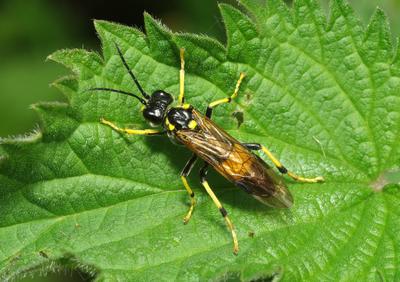 |
Tenthredo
maculata, (female)
© K.McGee |
HYMENOPTERA; ACULEATA
A total of 106 species recorded. This does not include the Ants but is
otherwise an accurate reflection as I have concentrated much more on this group
during recent years.
ANDRENINAE
Andrena bucephala. Scarce. Two females collected from Dandelions at Mill
Rough on 1.4.2008 and 12.4.2008. Confirmed by G.Trevis.
Andrena congruens. Rare. One male collected in-flight at Mill Rough on
30.5.2009.
Andrena labiata. Restricted. A female on Speedwells alongside Mill Rough
on 20.5.2009, another at the same spot on 23.5. Despite an intensive search I
couldn’t find one in Mill Meadow during the same period.
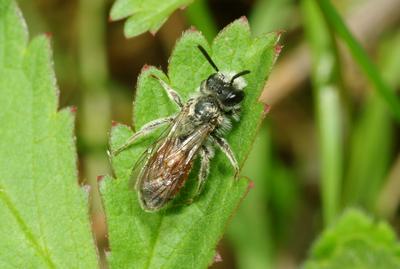 |
Andrena labiata,
(female)
© K.McGee |
ANTHOPHORINAE
Nomada ferruginata. Rare. One male collected on 22.4.2006 from Mill
Rough, confirmed by G.Trevis. Another male photographed at the same spot on
26.4.2008. The host Andrena for this cleptoparasite is A.praecox,
which is fairly common here.
Nomada striata. Widespread. This is present at Mill Meadow, but only in
very small numbers. It tends to emerge a little later than other Nomadas,
and can sometimes be found on flowers of Lesser Stitchwort. I have very few
records of this species away from Mill Meadow.
APINAE
Bombus rupestris. Scarce. Very rare here, one was photographed at rest on
Bluebells in Mill Meadow on 12.5.2007.
MEGACHILINAE
Anthidium manicatum. Widespread. A healthy population exists in Mill
Meadow. Males can be seen defending territories amongst Betony flowers during
late summer. This is the only site I know of.
Coelioxys rufescens. Widespread. One female from Mill Meadow, 14.6.2009.
Osmia caerulescens. Widespread. Breeds in the Oak stumps at Mill Meadow.
Males can be seen sunning themselves in late afternoon sunshine on and around
the stumps.
 |
Osmia caerulescens, (male)
© K.McGee |
CHRYSIDIDAE
Chrysis ruddii. Scarce. A male collected from an Oak stump at Mill
Meadow, 23.6.2009.
Omalus aeneus. Scarce. A male collected from Angelica flowers at Mill
Meadow, 2.8.2003.
POMPILIDAE
Auplopus carbonarius. Scarce. I have three females from Mill Meadow.
Anoplius caviventris. Very rare. A female collected from Mill Meadow on
8.6.2003 was subsequently confirmed by P.F.Whitehead.
SPHECIDAE
Argogorytes fargeii. Rare. A female collected from Hogweed flowers at
Mill Meadow, 14.6.2003.
Didineis lunicornis. Scarce. A female collected from dry ground in Mill
Meadow on 8.8.2004.










